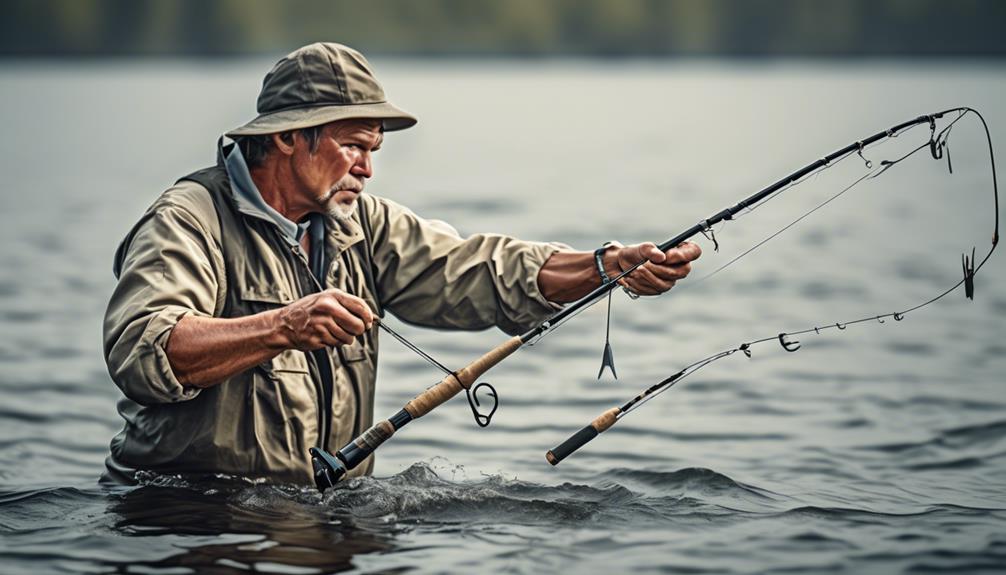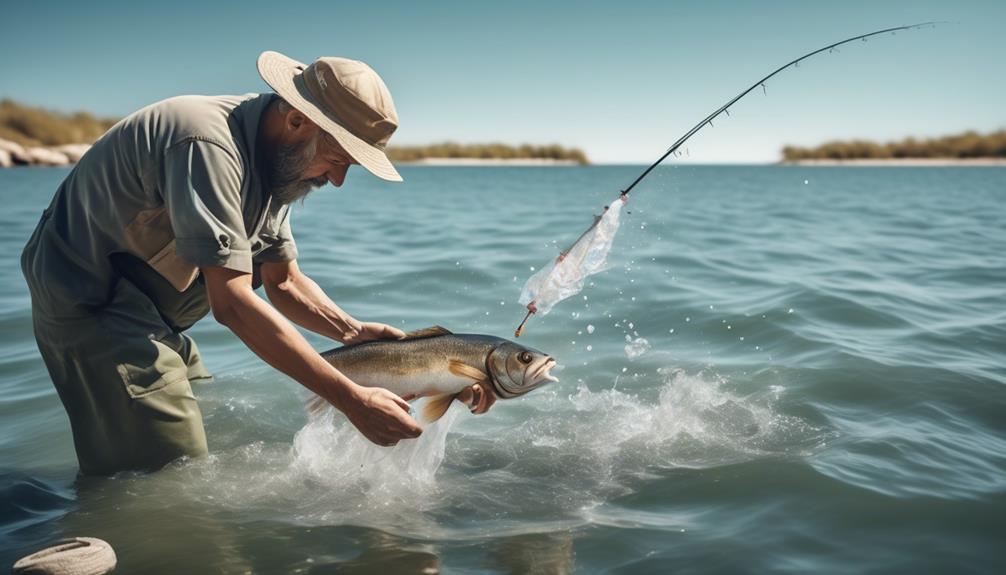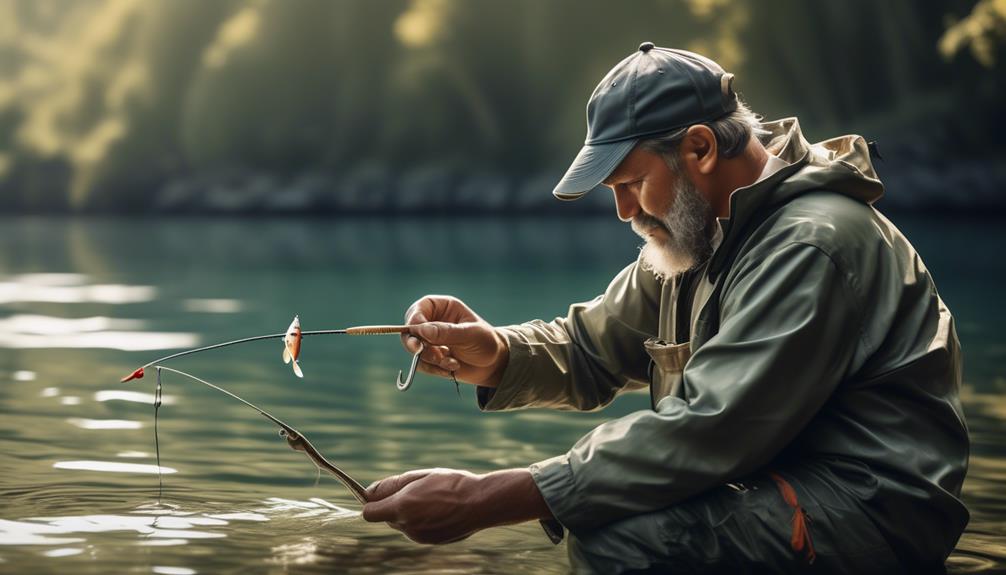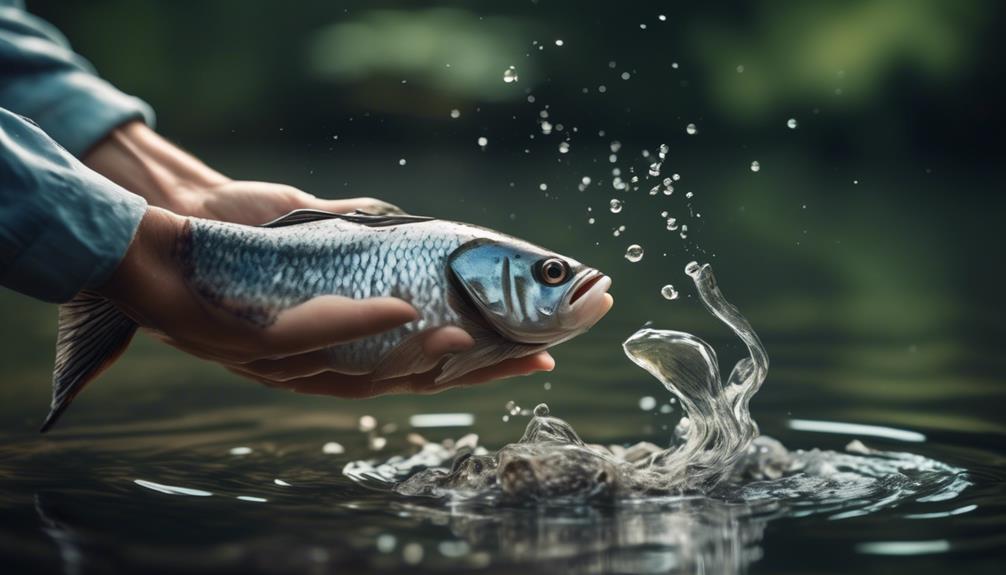When it comes to ensuring the well-being of the fish you catch and release, there are certain actions that can significantly improve their chances of survival. By implementing proper handling techniques and being mindful of factors such as hook type and fight time, you can greatly enhance the likelihood of a fish not only surviving, but thriving after being released.
It's essential to consider the various factors that contribute to the well-being of the fish, and by making informed choices, you can make a meaningful difference in their post-release survival.
Proper Handling Techniques
To enhance catch and release survival rates, it's crucial to employ proper handling techniques when handling fish. Fish stress is a significant factor in determining whether a fish will survive after being released. By learning appropriate handling methods, anglers can greatly reduce the stress that fish experience during the catch and release process. Angler education plays a vital role in promoting these proper techniques.
When catching a fish, it's important to handle it with care. Avoiding unnecessary contact with the fish's body can help minimize stress. Wetting your hands before handling the fish can prevent the removal of its protective slime layer, which is crucial for its health. Additionally, supporting the fish horizontally, rather than holding it vertically, can reduce the pressure on its internal organs and decrease the risk of injury. These simple yet effective techniques can make a significant difference in the fish's post-release survival.
Use of Barbless Hooks
Using barbless hooks when fishing can significantly reduce the potential harm to the fish during the catch and release process. This simple modification to your tackle can greatly enhance the survival rates of released fish.
Here's why using barbless hooks is beneficial:
- Hook Design: Barbless hooks are designed without the traditional barb, which is the small projection along the shank of the hook. This design makes it easier to remove the hook from the fish's mouth, reducing the handling time and potential damage to the fish.
- Fish Stress: When a fish is hooked, the lack of a barb means that the hook can be extracted more swiftly, causing less stress to the fish. Reduced handling time and stress contribute to the fish's overall well-being and the likelihood of survival after being released.
- Release Efficiency: Barbless hooks facilitate a quicker and more efficient release process. With barbless hooks, the fish is less likely to be further injured during the unhooking process, allowing for a smoother release back into the water.
Minimizing Fight Time

Barbless hooks not only reduce potential harm to the fish but also play a crucial role in minimizing fight time during the catch and release process. When you're using barbless hooks, you can more quickly and easily unhook the fish, reducing the amount of time it spends out of the water and minimizing stress. This stress reduction is vital for the fish's overall well-being and survival after release. By employing barbless hooks, you demonstrate ethical angling practices, showing respect for the fish and the environment.
In addition to using barbless hooks, there are other ways to minimize fight time and subsequently reduce stress on the fish. One effective technique is to use the proper gear for the type of fish you're targeting. This means using the right rod, line, and reel to ensure that you can reel in the fish efficiently without unnecessarily prolonging the fight. Properly adjusting the drag on your reel is also crucial. This allows you to tire out the fish in a controlled manner, shortening the fight time and minimizing stress on the fish.
Ultimately, the goal of minimizing fight time is to ensure the fish's well-being during catch and release. By employing stress reduction techniques and ethical angling practices, such as using barbless hooks and appropriate gear, you can enhance the survival rates of released fish and contribute to the sustainability of fisheries.
Avoiding Deep Hooking
When fishing, aim to minimize the risk of deep hooking to ensure the fish's well-being during catch and release. Deep hooking can cause severe injury to the fish, reducing its chances of survival after release. To avoid deep hooking and promote the well-being of the fish, consider the following:
- Proper Hook Removal: After a fish is hooked, it's crucial to handle it with care to avoid deep hooking. Use long-nose pliers or specialized hook removers to gently and swiftly remove the hook. Avoid excessive twisting or pushing, as these actions can cause the hook to penetrate deeper into the fish's flesh, leading to potential injury and reduced survival rates.
- Avoiding Barbed Hooks: When possible, opt for barbless hooks, as they're easier to remove and cause less damage to the fish. Barbless hooks minimize the risk of deep hooking and can significantly reduce the potential for injury.
- Injury Prevention: Be mindful of the size and type of hook being used. Using smaller hooks can decrease the likelihood of deep hooking, as they're more likely to catch in the fish's mouth rather than deeper within its throat or digestive system. Additionally, practicing proper fish handling techniques, such as supporting the fish in a horizontal position and minimizing air exposure, can further reduce the risk of injury during hook removal and release.
Appropriate Revival Methods
To increase the chances of a fish surviving after catch and release, it's important to employ appropriate revival methods that minimize stress and support the fish's recovery. Revival techniques play a crucial role in ensuring that the fish is able to swim away strongly after being released.
One important factor to consider is water temperature. If the water is warm, revival may be quicker, as the fish's metabolism is higher. However, in colder water, revival may take longer, and it's important to be patient and ensure the fish is fully recovered before releasing it.
Stress reduction is another key aspect of appropriate revival methods. When handling the fish, try to minimize the time it spends out of the water. Be gentle and avoid excessive handling, as this can increase stress levels. Additionally, consider the timing of the release. If the fish has been fighting for an extended period, it's important to give it enough time to recover before releasing it. Holding the fish in a gentle current can help provide oxygenated water to its gills, aiding in its recovery.
When practicing catch and release, it's important to be prepared with the knowledge and tools necessary to properly revive the fish. By employing appropriate revival methods, you can greatly increase the chances of the fish surviving after being released back into the water.
Choosing the Right Gear
Selecting the appropriate gear is essential for maximizing the effectiveness of catch and release practices. When it comes to choosing the right gear for catch and release fishing, there are several key considerations to keep in mind to ensure the well-being of the fish population and the environment.
Here are some important factors to consider:
- Gear maintenance and proper sizing: Regular maintenance of your fishing gear is crucial for ensuring that it functions properly and doesn't cause unnecessary harm to the fish. Check your equipment for any signs of wear and tear, and replace any damaged parts as needed. Additionally, using the correct gear size for the type of fish you're targeting can help minimize injury and maximize the chances of survival after release.
- Environmental impact and ethical considerations: When selecting gear for catch and release fishing, it's important to consider the potential environmental impact of the materials used. Opt for gear made from sustainable and environmentally friendly materials whenever possible. Furthermore, ethical considerations should also play a role in your gear choices. Avoid using gear that causes excessive harm to the fish or their habitat, and prioritize the well-being of the fish population.
Fishing in Optimal Conditions

Optimize your fishing experience by targeting optimal conditions for catch and release practices. Ideal weather and prime locations play crucial roles in ensuring the well-being of the fish you catch.
When it comes to ideal weather, consider factors such as temperature, wind, and precipitation. Fish are more active in moderate temperatures, so aim to fish during mild weather conditions. Additionally, calm winds and clear skies make for better fishing experiences, as they can help you maneuver your boat and spot fish more easily.
Prime locations also significantly impact catch and release success. Look for areas with abundant oxygen and suitable water temperatures, such as river confluences, deep pools, or areas near underwater structures where fish tend to congregate. These locations increase the likelihood of catching fish that are healthier and more resilient to the stress of being caught and released.
Understanding Fish Behavior
Understanding fish behavior is essential for improving your catch and release success and ensuring the well-being of the fish you encounter. By learning about fish behavior, you can better anticipate their movements and reactions, ultimately leading to a more successful and sustainable fishing experience.
Here are some important aspects of fish behavior to consider:
- Fish Feeding: Understanding the feeding habits of different fish species can help you select the right bait or lure and determine the best time of day for fishing.
- Spawning Habits: Knowing when and where fish spawn is crucial for avoiding disturbing them during this critical period, which could impact their reproductive success and overall population.
- Predator Avoidance and Migration Patterns: Being aware of how fish avoid predators and their migration patterns can assist in locating them more effectively and minimizing stress during catch and release.
Additionally, understanding fish habitat preferences and communication signals can provide valuable insights into where to find fish and how to approach them without causing unnecessary harm. By taking the time to learn about these behavioral aspects, you can become a more conscientious angler and contribute to the conservation of fish populations.
Frequently Asked Questions
What Are the Potential Long-Term Impacts of Catch and Release on Fish Populations?
Catch and release can have significant impacts on fish populations. However, through effective conservation efforts, the long-term impacts can be minimized. By using best practices such as proper handling and release techniques, as well as employing barbless hooks, you can help ensure the survival rates of released fish.
Conservation organizations also play a crucial role in educating anglers and promoting sustainable fishing practices to mitigate the potential negative effects of catch and release.
How Does Water Temperature Affect the Survival Rates of Released Fish?
Water temperature plays a crucial role in the survival rates of released fish. Thermal stress from extreme temperatures can impact fish behavior and physiological processes. High water temperatures can decrease oxygen levels, affecting fish physiology and increasing stress.
Conversely, low temperatures can slow down a fish's recovery process after release. It's important to consider water quality and temperature when releasing fish to maximize their chances of survival.
Are There Any Specific Regulations or Guidelines for Catch and Release in Different Fishing Locations?
When fishing in different locations, it's important to be aware of catch regulations and release guidelines to support conservation measures. Various fishing locations may have specific rules in place to ensure the survival of released fish. Familiarize yourself with these regulations and guidelines to promote sustainable fishing practices and contribute to the conservation of fish populations.
Always follow the catch and release rules set by the local authorities to help protect the aquatic ecosystem.
What Are the Potential Effects of Catch and Release on the Behavior and Feeding Patterns of Fish?
When you practice catch and release, behavior modification and feeding disruption are potential effects on fish.
The stress from being caught and handled can alter their behavior, making them more cautious or less likely to feed. This could impact their overall health and survival.
To minimize these effects, it's important to handle fish carefully, minimize air exposure, and release them quickly, ensuring they've the best chance of resuming normal behavior and feeding patterns.
How Can Anglers Contribute to Research and Data Collection on Catch and Release Survival Rates?
To contribute to research and enhance survival rates, angler involvement in data collection is crucial. By actively participating and sharing catch and release information, you can significantly contribute to ongoing research.
This will provide valuable data for understanding and improving survival rates of released fish. Your involvement can make a real difference in promoting sustainable fishing practices and ensuring the well-being of fish populations.
Conclusion
In conclusion, by practicing proper handling techniques, using barbless hooks, and minimizing fight time, you can significantly enhance catch and release survival rates.
Additionally, avoiding deep hooking and choosing the right gear are important factors in increasing survival rates.
Understanding fish behavior and fishing in optimal conditions are also crucial factors in ensuring the health and survival of the fish population for future generations.
By taking these actions, you can help ensure the health and survival of the fish population for future generations.



